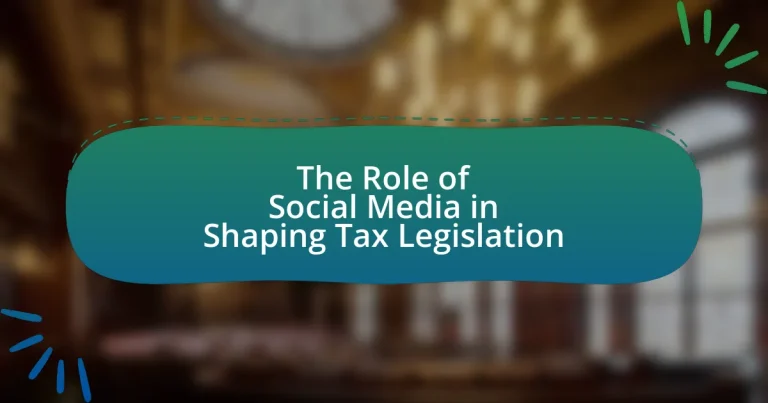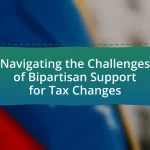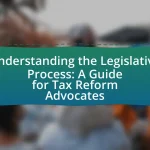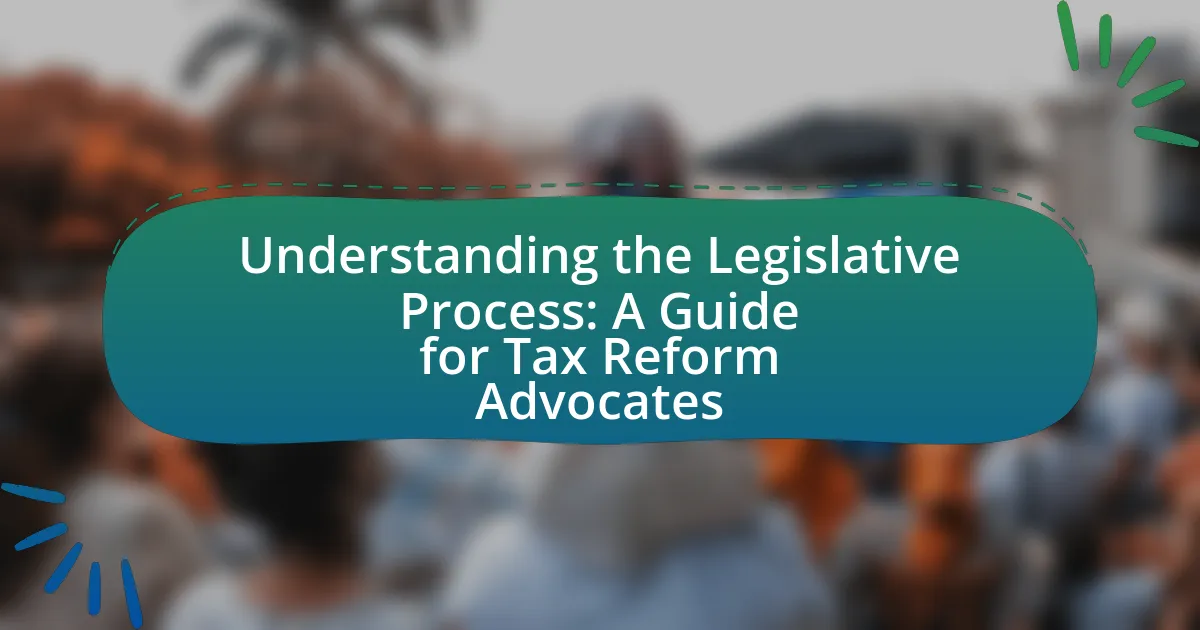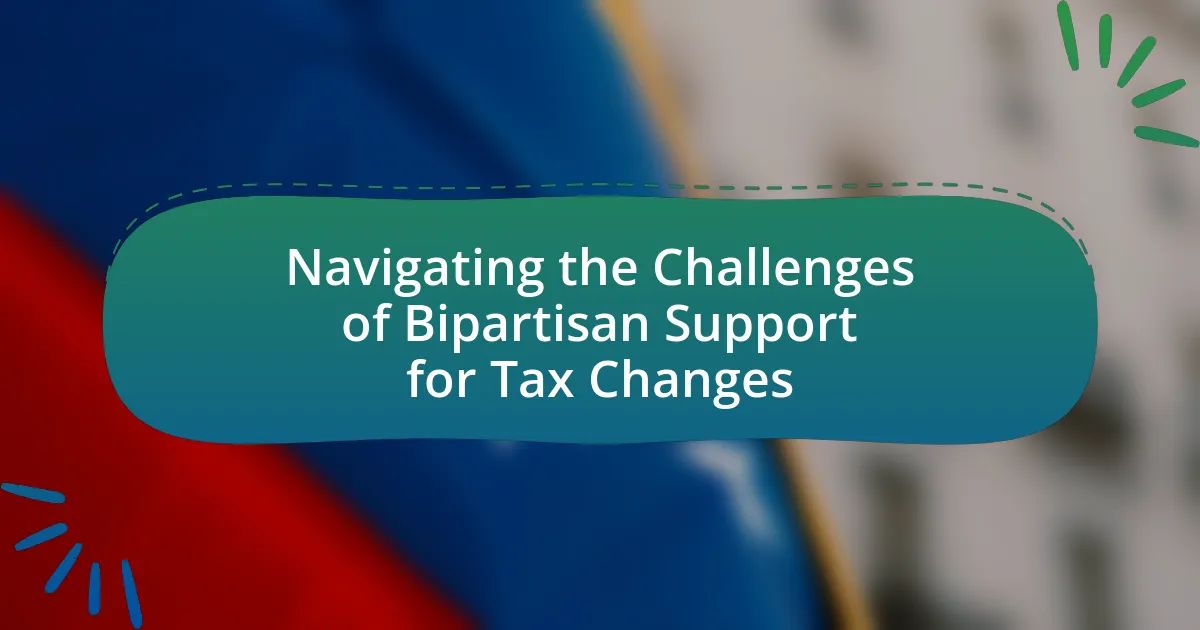The article examines the significant role of social media in shaping tax legislation, highlighting how platforms like Twitter and Facebook facilitate public discourse and grassroots advocacy. It discusses the influence of social media on public opinion regarding tax policies, the effectiveness of various platforms in fostering discussions, and the impact of social media campaigns on legislative outcomes. Additionally, the article addresses the challenges posed by misinformation and polarized opinions, while emphasizing the importance of social media as a tool for tax advocacy and communication between lawmakers and constituents. It concludes by exploring future trends and strategies for effective engagement in tax-related discussions on social media.
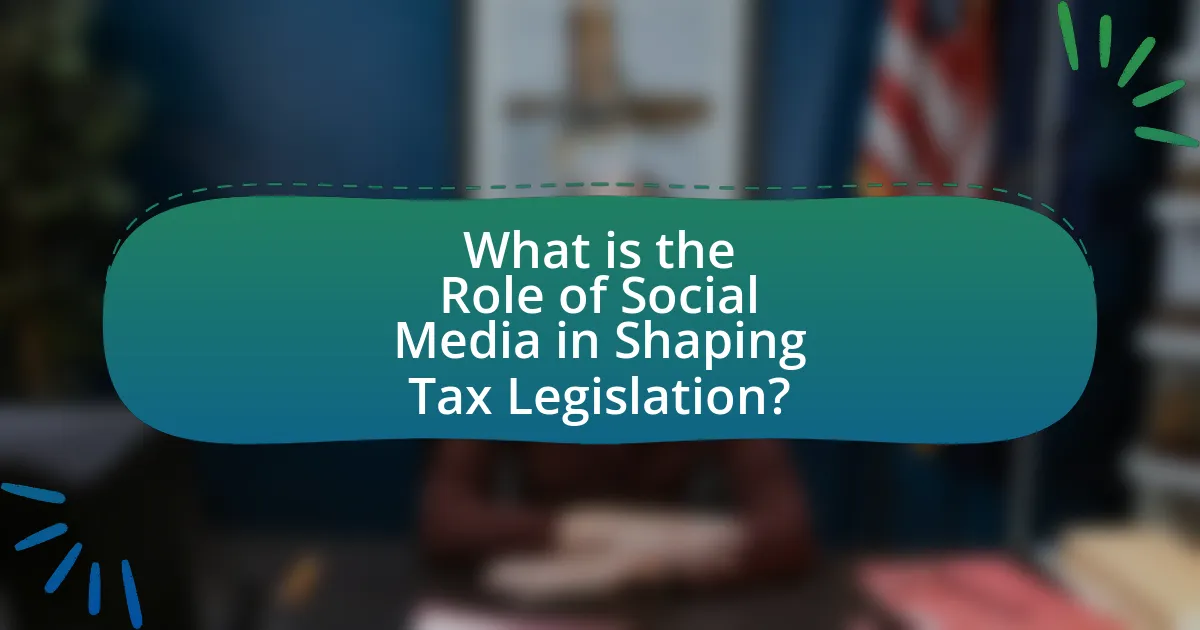
What is the Role of Social Media in Shaping Tax Legislation?
Social media plays a significant role in shaping tax legislation by facilitating public discourse and mobilizing grassroots advocacy. Platforms like Twitter and Facebook allow citizens to express their opinions on tax policies, which can influence lawmakers’ decisions. For instance, during the 2017 U.S. tax reform debate, social media campaigns helped raise awareness about the potential impacts of proposed changes, leading to increased public engagement and pressure on legislators. This demonstrates that social media serves as a powerful tool for amplifying voices and shaping the legislative agenda regarding taxation.
How does social media influence public opinion on tax policies?
Social media significantly influences public opinion on tax policies by facilitating the rapid dissemination of information and enabling user engagement. Platforms like Twitter and Facebook allow individuals to share their views, access diverse perspectives, and mobilize collective action, which can shape perceptions about tax issues. For instance, a study by the Pew Research Center found that 69% of adults in the U.S. use social media, and these platforms often serve as primary sources for news and information, including tax-related topics. This widespread usage means that discussions and debates on social media can quickly sway public sentiment, as seen during tax reform debates where trending hashtags and viral posts can amplify specific viewpoints and influence policymakers.
What platforms are most effective in shaping tax-related discussions?
Social media platforms such as Twitter, Facebook, and LinkedIn are most effective in shaping tax-related discussions. These platforms facilitate real-time communication and engagement among policymakers, tax professionals, and the public, allowing for the rapid dissemination of information and diverse viewpoints. For instance, a study by the Pew Research Center found that 69% of adults in the U.S. use Facebook, making it a significant channel for discussions on tax policy and legislation. Additionally, Twitter’s character limit encourages concise arguments and updates, which can quickly influence public opinion and legislative agendas.
How do social media campaigns impact legislative outcomes?
Social media campaigns significantly influence legislative outcomes by mobilizing public opinion and increasing awareness of specific issues. For instance, campaigns that effectively engage users can lead to heightened pressure on lawmakers to address constituents’ concerns, as seen in the 2017 Tax Cuts and Jobs Act, where social media played a crucial role in shaping public discourse and influencing voter sentiment. Research indicates that 70% of lawmakers reported using social media to gauge public opinion, demonstrating its impact on legislative priorities and decision-making processes.
Why is social media a critical tool for tax advocacy?
Social media is a critical tool for tax advocacy because it enables rapid communication and mobilization of public opinion. This platform allows advocates to disseminate information quickly, engage with a broad audience, and create grassroots movements that can influence policymakers. For instance, campaigns like #TaxJustice have successfully raised awareness about tax reforms, demonstrating how social media can amplify voices and drive legislative change. Additionally, studies show that social media engagement can significantly impact public perception and policy discussions, making it an essential component of modern tax advocacy strategies.
What are the advantages of using social media for tax advocacy?
Using social media for tax advocacy offers several advantages, including increased reach, enhanced engagement, and real-time communication. Social media platforms allow tax advocates to connect with a broader audience, facilitating the dissemination of information to diverse demographics. For instance, a study by the Pew Research Center indicates that 69% of adults in the U.S. use social media, providing a vast potential audience for tax-related messages.
Additionally, social media fosters greater engagement by enabling two-way communication, allowing advocates to interact directly with constituents, answer questions, and address concerns. This interaction can lead to a more informed public and increased participation in tax policy discussions. Furthermore, real-time communication on social media allows advocates to respond swiftly to legislative changes or public sentiment, ensuring that their messaging remains relevant and impactful.
Overall, the advantages of using social media for tax advocacy include the ability to reach a large audience, engage effectively with the public, and communicate in real-time, all of which contribute to more effective advocacy efforts.
How do grassroots movements leverage social media for tax reforms?
Grassroots movements leverage social media for tax reforms by mobilizing supporters, disseminating information, and amplifying their message to a broader audience. These movements utilize platforms like Twitter, Facebook, and Instagram to share compelling narratives and data that highlight the need for tax reform, thereby increasing public awareness and engagement. For instance, the “Tax March” movement in 2017 effectively used social media to organize nationwide protests, advocating for transparency in tax returns and equitable tax policies. This strategic use of social media not only facilitated real-time communication but also enabled grassroots organizations to connect with influential stakeholders and policymakers, thereby enhancing their advocacy efforts.
What challenges does social media present in tax legislation discussions?
Social media presents challenges in tax legislation discussions by facilitating the rapid spread of misinformation and creating polarized opinions. The immediacy of social media allows inaccurate information about tax policies to circulate widely, leading to public confusion and misinterpretation of legislative proposals. For instance, a study by the Pew Research Center found that 64% of Americans believe that social media has a mostly negative effect on the way things are going in the country, indicating a general skepticism about the reliability of information shared online. Additionally, social media platforms can amplify extreme viewpoints, making it difficult for nuanced discussions about tax legislation to occur, as users often engage with content that aligns with their pre-existing beliefs rather than considering diverse perspectives.
How can misinformation on social media affect tax policy debates?
Misinformation on social media can significantly distort tax policy debates by shaping public perception and influencing policymakers. When false information circulates, it can lead to misconceptions about tax implications, such as the effects of tax increases or the benefits of tax cuts, which may sway public opinion and pressure legislators to act against evidence-based policy. For instance, a study by the Pew Research Center found that 64% of Americans believe misinformation has a major impact on their understanding of political issues, including taxation. This distortion can result in poorly informed decisions that do not reflect the actual needs or economic realities, ultimately undermining effective tax legislation.
What are the risks of relying on social media for tax-related information?
Relying on social media for tax-related information poses significant risks, including the dissemination of inaccurate or misleading information. Social media platforms often lack rigorous fact-checking processes, leading to the spread of rumors or unverified claims about tax laws and regulations. For instance, a study by the Pew Research Center found that 64% of Americans believe misinformation is a major problem on social media, which can directly impact individuals’ understanding of their tax obligations. Additionally, the rapid nature of social media can result in outdated information being shared, as tax laws frequently change. This combination of inaccuracy and timeliness issues can lead to costly mistakes in tax filing and compliance.
How does social media facilitate communication between lawmakers and constituents?
Social media facilitates communication between lawmakers and constituents by providing a direct and immediate platform for interaction. Lawmakers utilize social media to share information, solicit feedback, and engage in discussions with their constituents, which enhances transparency and accountability. For instance, a study by the Pew Research Center found that 69% of adults in the U.S. use social media, allowing lawmakers to reach a broad audience quickly and efficiently. This two-way communication enables constituents to express their opinions on tax legislation and other issues, fostering a more participatory democratic process.
What role does social media play in the transparency of tax legislation?
Social media enhances the transparency of tax legislation by facilitating real-time communication and engagement between lawmakers and the public. Platforms like Twitter and Facebook allow citizens to access information about tax policies, participate in discussions, and express their opinions, thereby increasing accountability. For instance, a study by the Pew Research Center found that 69% of adults in the U.S. use social media, which enables widespread dissemination of legislative updates and fosters public scrutiny. This dynamic encourages lawmakers to be more transparent in their decision-making processes, as they are aware that their actions are subject to public observation and critique.
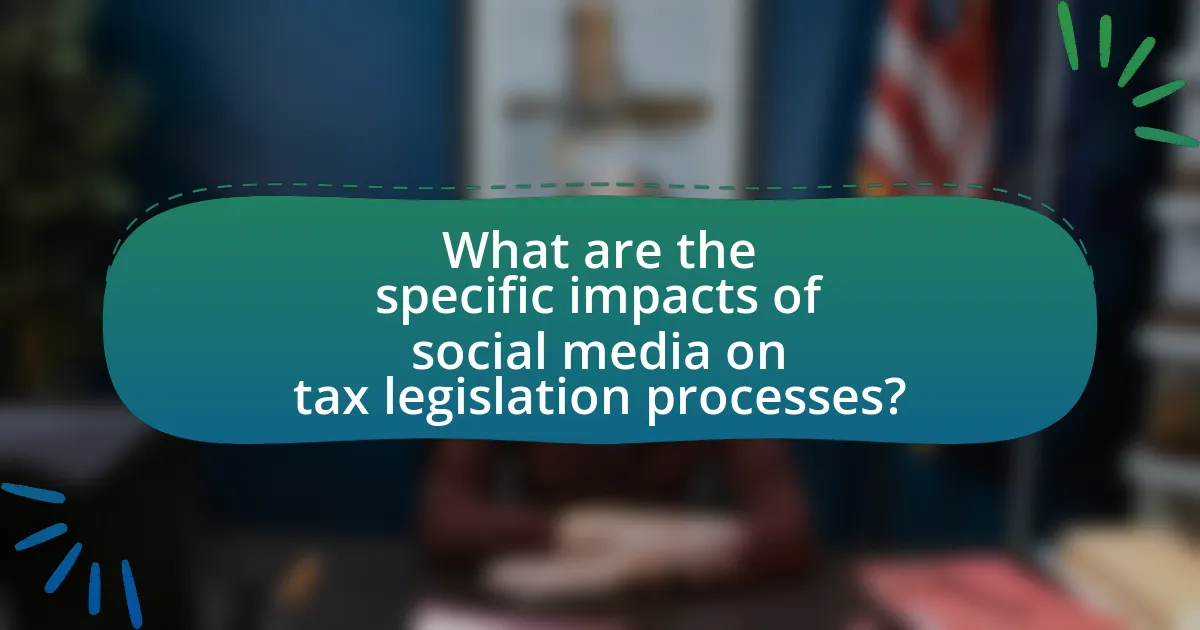
What are the specific impacts of social media on tax legislation processes?
Social media significantly influences tax legislation processes by facilitating public engagement and shaping policy discussions. Platforms like Twitter and Facebook enable citizens to voice their opinions, mobilize support for specific tax reforms, and hold lawmakers accountable. For instance, the 2017 U.S. tax reform debate saw extensive social media campaigns that amplified public sentiment, leading to increased pressure on legislators to consider constituents’ views. Additionally, social media serves as a rapid information dissemination tool, allowing stakeholders to share research, data, and expert opinions that can inform legislative decisions. This dynamic interaction between lawmakers and the public can lead to more responsive and transparent tax policies.
How do social media trends correlate with tax policy changes?
Social media trends significantly influence tax policy changes by shaping public opinion and mobilizing grassroots movements. For instance, viral campaigns on platforms like Twitter and Facebook can raise awareness about tax issues, prompting policymakers to respond to constituents’ concerns. A notable example is the 2017 Tax Cuts and Jobs Act in the United States, where social media played a crucial role in both supporting and opposing the legislation, reflecting the public’s sentiments and leading to adjustments in the final bill. Research indicates that social media engagement correlates with increased political participation, which can directly impact legislative outcomes, including tax policies.
What examples illustrate the impact of social media on recent tax legislation?
Social media has significantly influenced recent tax legislation, particularly through grassroots movements and public advocacy campaigns. For instance, the #TaxTheRich movement gained traction on platforms like Twitter and Instagram, leading to increased public support for higher taxes on the wealthy, which was reflected in proposals by lawmakers such as Senator Elizabeth Warren. Additionally, social media campaigns surrounding the taxation of digital services prompted legislative discussions in various countries, including the European Union’s Digital Services Tax, which aimed to address the tax challenges posed by large tech companies. These examples demonstrate how social media can mobilize public opinion and pressure legislators to consider new tax policies.
How do lawmakers respond to social media feedback on tax issues?
Lawmakers respond to social media feedback on tax issues by actively monitoring public sentiment and engaging with constituents through platforms like Twitter and Facebook. This engagement allows them to gauge public opinion, address concerns, and adjust their legislative priorities accordingly. For instance, a study by the Pew Research Center found that 69% of U.S. adults use social media, making it a vital tool for lawmakers to understand the electorate’s views on tax policies. Additionally, lawmakers often use social media to communicate their positions and clarify misconceptions, thereby fostering a dialogue that can influence tax legislation.
What strategies can be employed to effectively use social media in tax advocacy?
To effectively use social media in tax advocacy, organizations should employ targeted messaging, engage with followers, and utilize data analytics. Targeted messaging involves crafting specific content that resonates with the audience’s interests and concerns regarding tax issues, which can increase engagement and awareness. Engaging with followers through interactive posts, Q&A sessions, and live discussions fosters a sense of community and encourages dialogue about tax policies. Utilizing data analytics allows advocates to track engagement metrics, understand audience demographics, and refine strategies based on what content performs best, ensuring that advocacy efforts are both efficient and impactful.
What best practices should advocates follow when using social media for tax issues?
Advocates should follow best practices such as ensuring accuracy, maintaining professionalism, engaging with followers, and utilizing data-driven insights when using social media for tax issues. Accuracy is crucial; advocates must verify facts and figures before sharing to avoid misinformation, as incorrect data can mislead the public and undermine credibility. Maintaining professionalism involves using respectful language and tone, which fosters constructive dialogue and enhances the advocate’s reputation. Engaging with followers by responding to comments and questions encourages community involvement and builds trust. Lastly, utilizing data-driven insights allows advocates to tailor their messages effectively, ensuring they resonate with their audience and address relevant tax concerns. These practices collectively enhance the effectiveness of advocacy efforts on social media platforms.
How can data analytics enhance social media campaigns related to tax legislation?
Data analytics can enhance social media campaigns related to tax legislation by providing insights into audience behavior, preferences, and engagement patterns. By analyzing data from social media interactions, organizations can identify which topics resonate most with their audience, allowing for targeted messaging that addresses specific concerns or interests regarding tax legislation. For instance, a study by the Pew Research Center found that 69% of adults in the U.S. use social media, indicating a significant platform for disseminating information. Furthermore, analytics can track the effectiveness of different campaign strategies in real-time, enabling adjustments to optimize reach and impact. This data-driven approach ensures that campaigns are not only relevant but also effective in influencing public opinion and engagement with tax-related issues.
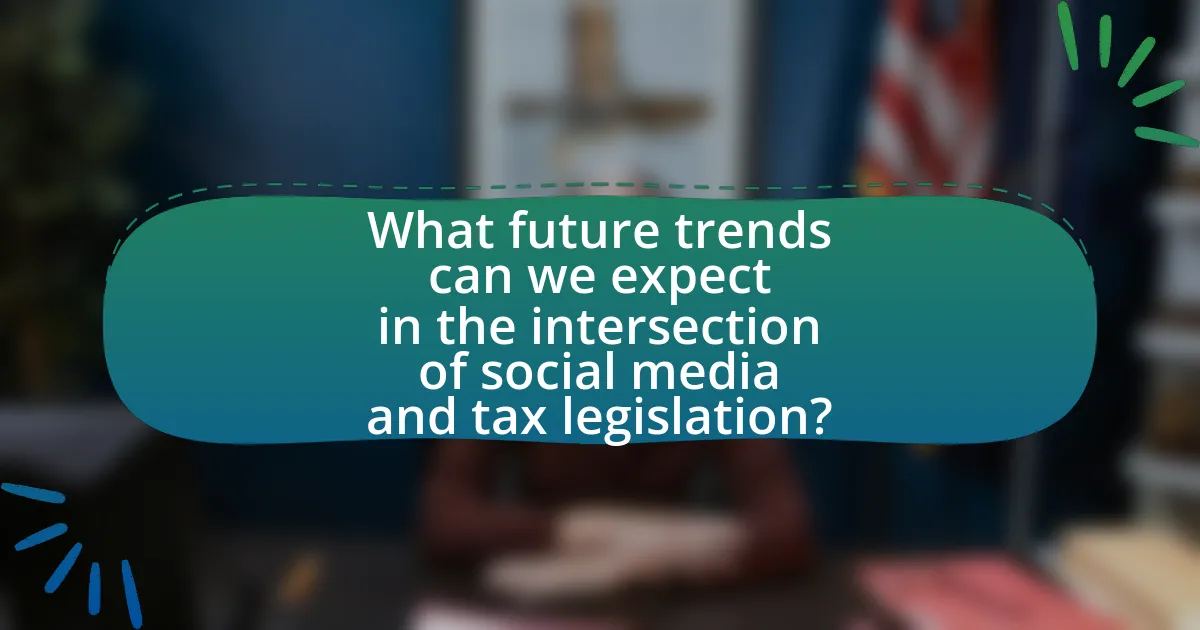
What future trends can we expect in the intersection of social media and tax legislation?
Future trends in the intersection of social media and tax legislation will likely include increased regulatory scrutiny and the implementation of digital taxation frameworks. As social media platforms continue to grow in influence and revenue generation, governments are recognizing the need to adapt tax laws to capture income generated through these channels. For instance, the OECD has been advocating for a global minimum tax rate, which could impact how social media companies are taxed across different jurisdictions. Additionally, social media will serve as a tool for public engagement and awareness regarding tax policies, leading to more informed citizen participation in legislative processes. This trend is supported by the rise of online campaigns and discussions that shape public opinion and influence lawmakers.
How might emerging technologies influence social media’s role in tax advocacy?
Emerging technologies significantly enhance social media’s role in tax advocacy by enabling more effective communication and engagement strategies. For instance, artificial intelligence algorithms can analyze vast amounts of data to identify key tax issues and target specific demographics with tailored messages, increasing the likelihood of mobilizing public support. Additionally, blockchain technology can provide transparency in tax-related transactions, fostering trust and accountability among stakeholders. According to a 2021 study by the Pew Research Center, 69% of Americans believe social media is an effective platform for raising awareness about social issues, including tax policy. This indicates that as emerging technologies evolve, they will likely amplify the impact of social media in advocating for tax reforms and influencing legislative changes.
What potential changes in user behavior could affect tax discussions on social media?
Changes in user behavior that could affect tax discussions on social media include increased engagement with tax-related content, shifts towards more personalized and localized discussions, and the rise of misinformation. Increased engagement can lead to a greater volume of conversations, influencing public opinion and potentially shaping tax policy. Personalized discussions may focus on specific tax issues relevant to individual users, fostering a more nuanced dialogue. The rise of misinformation can skew perceptions of tax policies, leading to confusion and potentially impacting legislative outcomes. For instance, a study by the Pew Research Center found that 64% of Americans believe misinformation is a major problem in the news, which can extend to tax discussions on social media platforms.
How can policymakers adapt to the evolving landscape of social media in tax legislation?
Policymakers can adapt to the evolving landscape of social media in tax legislation by integrating real-time data analysis and public sentiment tracking into their legislative processes. This approach allows them to understand the impact of social media discourse on tax policy and public opinion. For instance, studies have shown that social media platforms can significantly influence public perceptions of tax fairness and compliance, as evidenced by the 2020 Pew Research Center report, which found that 64% of Americans believe social media shapes their views on government policies. By leveraging this data, policymakers can create more responsive and relevant tax legislation that reflects the concerns and priorities of their constituents.
What practical tips can individuals and organizations use to engage effectively on social media regarding tax legislation?
Individuals and organizations can engage effectively on social media regarding tax legislation by sharing accurate information, utilizing visuals, and fostering discussions. Sharing accurate information ensures that followers receive reliable updates about tax changes, which can be supported by citing official sources like the IRS or government publications. Utilizing visuals, such as infographics or charts, can simplify complex tax concepts, making them more accessible and shareable. Fostering discussions by asking questions or encouraging comments allows for community engagement, which can lead to a broader understanding of tax issues. Engaging with followers through timely responses and addressing their concerns can further enhance the dialogue around tax legislation.
